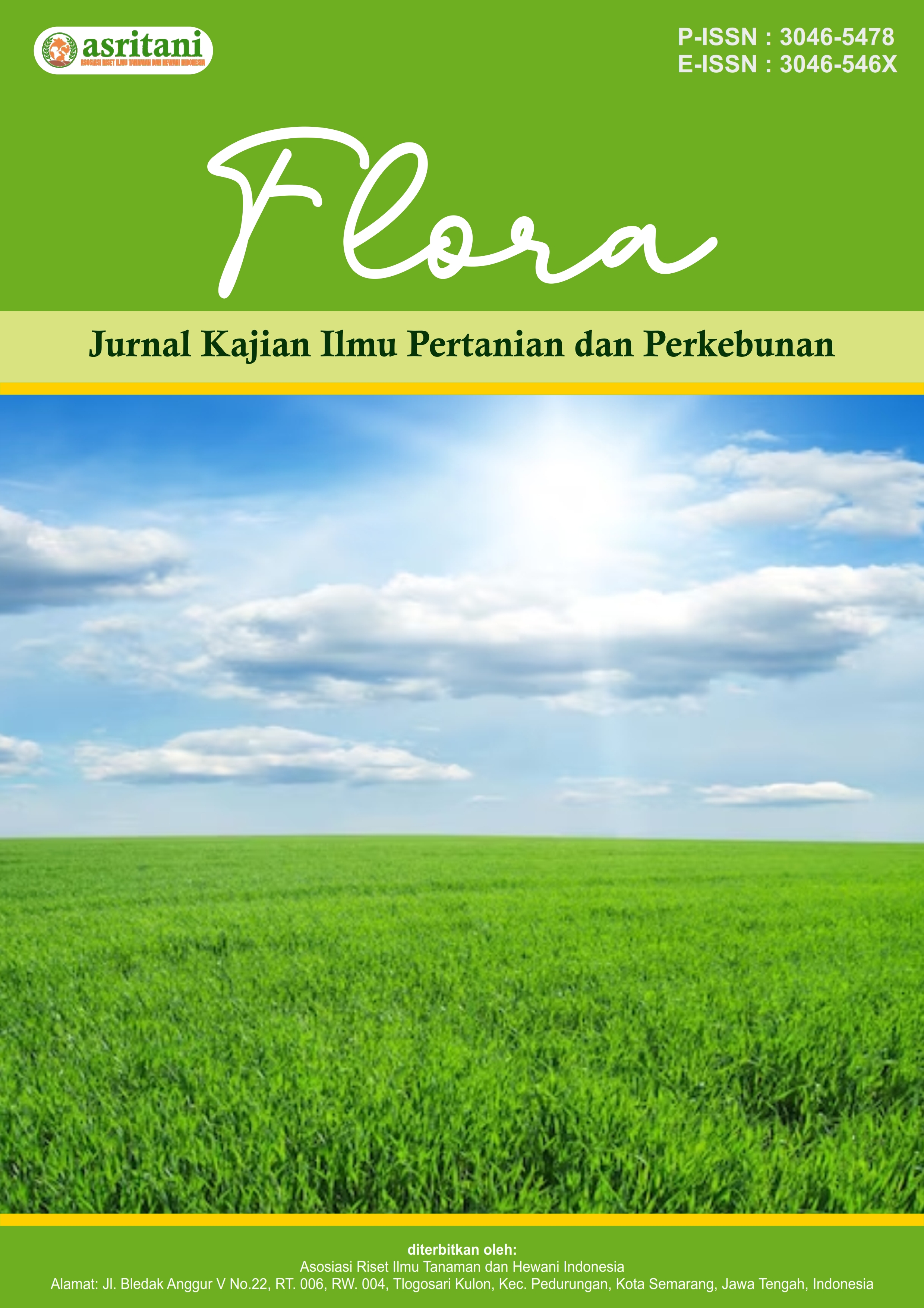Perbandingan Pengaruh Aktivator Effective Microorganisme 4 (EM 4) dan Promoting Microbes (PROMI) Terhadap Kualitas Kompos Organik Di Industri Galangan Kapal
DOI:
https://doi.org/10.62951/flora.v1i2.35Keywords:
Shipbuilding Industry, Organik Waste, Compost, Effective Microorganisms 4 (EM 4), Promoting Microbes (PROMI)Abstract
Shipbuilding industrial companies still produce a number of organic waste in the form of twigs, grass and leaves. In line with developments in the current era, organic waste that accumulates will become an issue for the environment if it is not managed properly. This activity was carried out to overcome the problem of organic waste in the shipbuilding industry, by utilizing organic waste for composting. Composting is a simple anaerobic method that can be easily carried out in the shipbuilding industry. This method turns organic waste into compost by carrying out a fermentation process. Organic waste in the form of leaves that are turned into compost can increase the nutrient content in the soil. The composting process is carried out using two different activator materials, namely using Effective Microorganisms 4 (EM 4) and Promoting Microbes (PROMI). The results of the compost research carried out have met the quality standards according to SNI 19-7030-2004. The final results of these two treatments are not too different, the pH resulting from the EM4 activator treatment is 6.9 and the pH from the PROMI activator treatment is 7. The temperature value for both does not exceed the ground water temperature, namely the final temperature of the EM4 activator treatment is 29.9oC and from PROMI activator treatment of 30oC. The observation results show that of the two activators EM4 and PROMI, the one that is more effectively used for composting is the EM4 activator because the microorganism content in EM4 has more classifications compared to the PROMI activator.
References
Amalia, D. W., & Widiyaningrum, P. (2016). PENGGUNAAN EM4 DAN MOL LIMBAH TOMAT SEBAGAI BIOAKTIVATOR PADA PEMBUATAN KOMPOS. In 18 LS (Vol. 5, Issue 1). http://journal.unnes.ac.id/sju/index.php/UnnesJLifeSci
Badan Standarisasi Nasional. (2004). Standar Nasional Indonesia Spesifikasi kompos dari sampah organik domestik Badan Standardisasi Nasional.
Chusna, N. A. (2021). Studi Kualitas Kompos Dengan Pemanfaatan Air Lindi Tempat Pemrosesan Akhir Sampah. Dampak, 18(2), 63. https://doi.org/10.25077/dampak.18.2.63-67.2021
Dahlia, I. (2015). PEMANFAATAN SAMPAH ORGANIK SEBAGAI BAHAN BAKU PUPUK KOMPOS DAN PENGARUHNYA TERHADAP TANAMAN DANTANAH. 10(1), 13.
Dewi S, F. M., & Kusnoputranto, H. (2022a). Analisis Kualitas Kompos dengan Penambahan Bioaktivator EM4 dan Molase dengan Metode Takakura. Poltekita : Jurnal Ilmu Kesehatan, 16(1), 67–73. https://doi.org/10.33860/jik.v16i1.1039
Dinata, H., Hidayatul, A., Qoimah, M., & Hidayat, R. (2022). PENGOLAHAN LIMBAH ORGANIK UNTUK PEMBUATAN PUPUK KOMPOS DAN PUPUK ORGANIK CAIR DI DESA DENA KECAMATAN MADAPANGGA KABUPATEN BIMA NUSA TENGGARA BARAT. 5(1), 9–13.
Hastuti, S., Martini, T., Purnawan, C., Masykur, A., & Wibowo, A. H. (2021). Pembuatan Kompos Sampah Dapur dan Taman dengan Bantuan Aktivator EM4. Proceeding of Chemistry Conferences, 6, 18. https://doi.org/10.20961/pcc.6.0.55084.18-21
Nisa, D., Arifin, D., Karakteristik, Z., Kompos, K., Baku, B., Limbah, C., Dan, B., Sapi, K., Dikomposkan, Y., Berbagai, D., Dekomposer, J., Nisa, D., Susilowati, L. E., & Arifin, Z. (2024). QUALITY CHARACTERISTICS OF COMPOST BASED ON A MIXTURE OF BAGLOG WASTE AND COW MANURE COMPOSTED WITH VARIOUS TYPES OF DECOMPOSER. 34(1).
Nurkhasanah, E., Candra Ababil, D., Danang Prayogo, R., Damayanti, A., Keolahragaan, I., Ilmu Keolahragaan, F., & Negeri Semarang, U. (2021). Pembuatan Pupuk Kompos dari Daun Kering. Jurnal Bina Desa, 3(2), 109–117. https://journal.unnes.ac.id/nju/index.php/jurnalbinadesa
R. Nurjasmi. (2016). Karakteristik Kompos Asal Berbagai Jenis Limbah Organik Dengan Penambahan Beberapa Macam Bioaktivator. 2(9), 618–625.
Rani Wandansari, N., Suntari, R., & Pembangunan Pertanian Malang, P. (2020). Pembuatan kompos dari sampah pasar dengan teknologi open-windrow. In AGROINOTEK: Jurnal Penelitian dan Pengabdian Masyarakat (Vol. 1). http://www.agroinotek.ub.ac.id
Reza Alief Chairin Nur, A. (2019). EFEKTIFITAS MIKROORGANISME LOKAL (MoL) LIMBAH NASI SEBAGAI AKTIF ATOR PEMBUATAN PUPUK KOMPOS ORGANIK EFFECTIVENESS OF LOCAL MICROORGANISM OF WASTE RICE AS ACTIVATOR OF PRODUCING ORGANIK COMPOST FERTILIZER.
SK Pembuatan Kompos Organik. (2023). SK PEMBUATAN KOMPOS ORGANIK PEMBUATAN KOMPOS ORGANIK K3LH / HSE.
Suharno, Wardoyo, S., & Anwar, T. (2021). Perbedaan Penggunaan Komposter An-Aerob dan Aerob Terhadap Laju Proses Pengomposan Sampah Organik. Poltekita : Jurnal Ilmu Kesehatan, 15(3), 251–255. https://doi.org/10.33860/jik.v15i3.527
Trivana, L., Yudha, A., Balai, P., Tanaman, P., Jalan, P., & Mapanget, R. (2017). Optimalisasi Waktu Pengomposan dan Kualitas Pupuk Kandang dari Kotoran Kambing dan Debu Sabut Kelapa dengan Bioaktivator PROMI dan Orgadec Time Optimization of the Composting and Quality of Organik Fertilizer Based on Goat Manure and Coconut Coir Dust using PROMI and Orgadec Bio-Activator.
Utomo, S., Setiastuti, N., Pengkajian Industri Manufaktur, P., & Dan Elektronika Kedeputian Pengkajian Kebijakan Teknologi -BPPT, T. (2019). Penerapan Metode Technometrik Untuk Penilaian Kapabilitas Teknologi Industri Galangan Kapal Dalam Menyongsong Era Industri 4.0. In Jurnal Sains Komputer & Informatika (J-SAKTI (Vol. 3). http://tunasbangsa.ac.id/ejurnal/index.php/jsakti
Valentino Pipiana, P., Sunarsih, S., Pratiwi, Y., & Teknik Lingkungan, J. (2024). Perbandingan Efektivitas Bioaktivator MOL Kulit Pisang Kepok (Musa paradisiaca L.) dan EM4 Dalam Pengomposan Limbah Daun Srobilanthes cusia Secara Aerob. IX(1).
Zuchri, T., Batubara, A. U., & Adiansyah, A. (2021). SISTEM PEMANTAUAN PH, TEMPERATUR DAN KELEMBABAN PADA PEMBUATAN PUPUK KOMPOS. JURNAL ANALIS LABORATORIUM MEDIK, 6(2), 100–106. https://doi.org/10.51544/jalm.v6i2.2232
Downloads
Published
How to Cite
Issue
Section
License
Copyright (c) 2024 Flora : Jurnal Kajian Ilmu Pertanian dan Perkebunan

This work is licensed under a Creative Commons Attribution-ShareAlike 4.0 International License.





